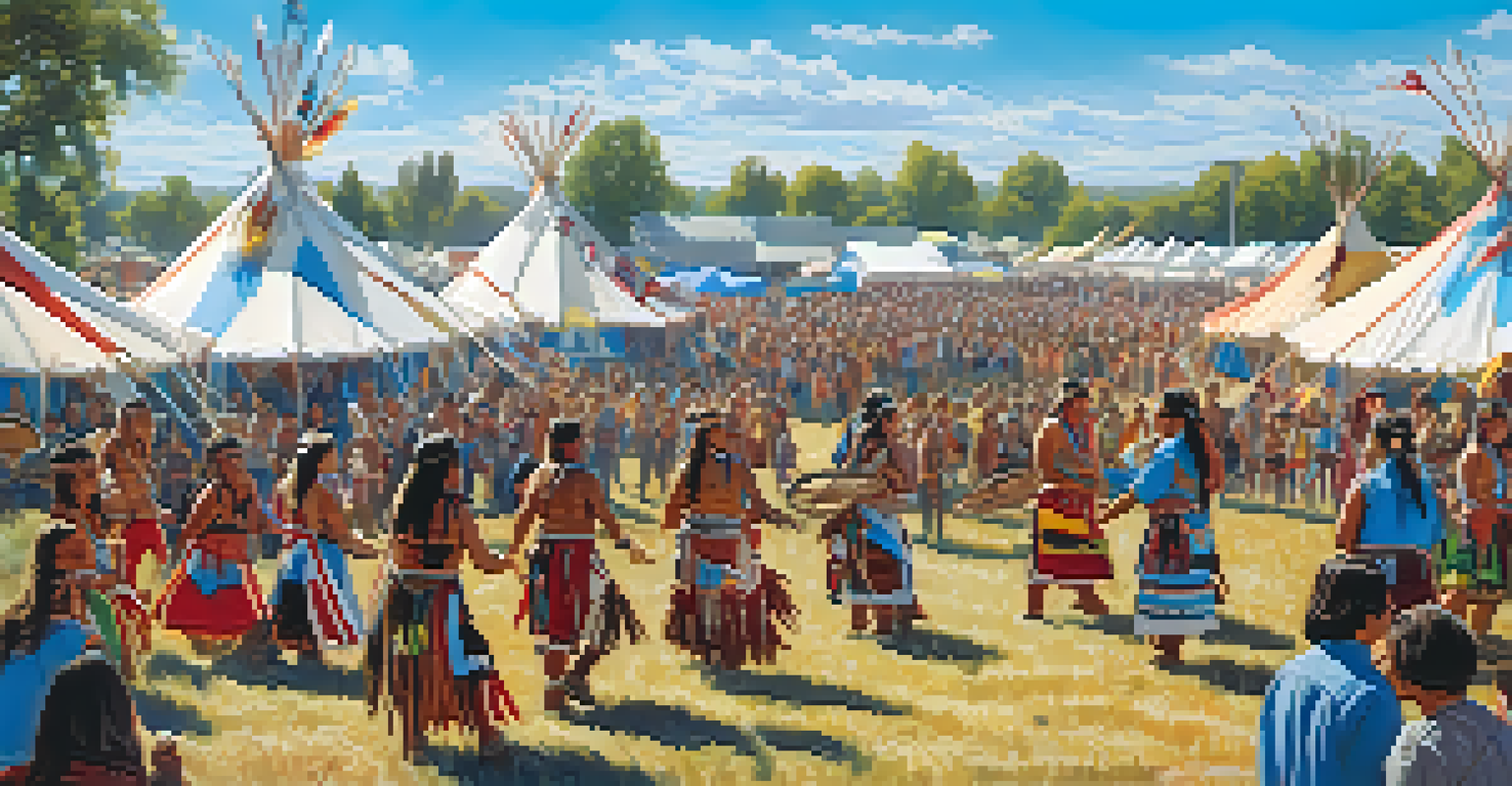The Origins of Native American Tribes in Sacramento Valley

The Rich Cultural Tapestry of the Sacramento Valley
The Sacramento Valley is home to a vibrant tapestry of Native American tribes, each with its unique culture and history. These tribes have thrived in the region for thousands of years, adapting to the lush landscapes and abundant resources. From the fertile riverbanks to the foothills, their connection to the land runs deep, shaping their traditions and lifestyles.
The earth does not belong to us; we belong to the earth.
The primary tribes in the Sacramento Valley include the Nisenan, Maidu, and Miwok, among others. Each tribe has its distinct language, customs, and spiritual beliefs, contributing to the area’s rich cultural diversity. Understanding these tribes helps to appreciate the historical significance of their presence and the profound impact they had on the region.
Moreover, the interplay between these tribes and their environment demonstrates a harmonious relationship with nature. They utilized the natural resources available to them, such as fish, game, and plants, fostering a sustainable way of life that respected the land's offerings.
Historical Context: The Arrival of Native Tribes
The origins of Native American tribes in the Sacramento Valley can be traced back thousands of years, long before European contact. Archaeological evidence suggests that these tribes settled in the region around 5000 BCE, establishing complex societies that thrived off the land's bounty. This period marked the beginning of a rich cultural heritage that would endure through time.

As hunters and gatherers, these early inhabitants developed extensive knowledge of their environment. They created intricate systems of trade and communication, connecting with neighboring tribes and facilitating the exchange of goods and ideas. This web of interaction not only strengthened their communities but also enriched their cultural practices.
Cultural Heritage of Native Tribes
The Sacramento Valley is rich in cultural diversity, shaped by the unique traditions and histories of Native American tribes like the Nisenan, Maidu, and Miwok.
The arrival of European settlers in the 19th century dramatically altered the landscape for these tribes. With the influx of newcomers, many Native American communities faced displacement, resource depletion, and significant cultural disruption, leading to profound changes in their way of life.
Tribal Identity and Language Preservation Efforts
Language plays a crucial role in preserving the cultural identity of Native American tribes in the Sacramento Valley. Each tribe has its own language, which carries traditional stories, songs, and knowledge passed down through generations. Efforts to revitalize and maintain these languages are ongoing, as they are vital to cultural continuity.
In every deliberation, we must consider the impact of our decisions on the next seven generations.
Organizations and tribal leaders are working tirelessly to implement language programs aimed at teaching younger generations their ancestral tongues. These efforts not only help preserve linguistic heritage but also foster a sense of pride and connection to their roots. Language revitalization is a powerful tool in sustaining cultural identity amidst the challenges of modern society.
In addition to language, many tribes are engaging in cultural events and traditional practices to reinforce their identity. Powwows, storytelling sessions, and craft workshops serve as platforms for sharing their heritage, strengthening community bonds, and educating the public about their rich history.
Spiritual Beliefs and Connection to Nature
Spiritual beliefs among Native American tribes in the Sacramento Valley are deeply intertwined with their connection to nature. Many tribes view the land, animals, and plants as sacred, deserving of respect and gratitude. This perspective shapes their practices, rituals, and communal life, emphasizing a harmonious existence with the environment.
Ceremonies and rituals often revolve around natural cycles, such as the changing seasons or lunar phases. These events serve not only as spiritual observances but also as communal gatherings that reinforce social ties. The teachings of these traditions emphasize stewardship of the land, reflecting a profound understanding of ecological balance.
Impact of Colonization
European colonization profoundly disrupted Native American communities, leading to displacement, cultural loss, and significant population decline due to introduced diseases.
Through storytelling, tribes pass down lessons about their relationship with the earth, highlighting the importance of sustainability. This cultural emphasis on nature has modern implications, as many Native American communities advocate for environmental justice and protection of their ancestral lands.
Impact of Colonization on Native American Tribes
The impact of colonization on Native American tribes in the Sacramento Valley was profound and often devastating. European settlers brought new diseases, which decimated populations unaccustomed to such illnesses. Additionally, the encroachment on their lands led to forced relocations and significant cultural disruption.
The Gold Rush in the mid-1800s further intensified these challenges as settlers flooded into the region, leading to violent conflicts over land and resources. Many tribes were pushed into marginalized territories, struggling to maintain their traditional lifestyles. This period marked a significant turning point, as tribes faced existential threats to their cultural and physical survival.
Despite these hardships, many Native American communities demonstrated resilience and adaptability. They formed alliances, engaged in negotiations, and fought to preserve their rights and identities amid the changing socio-political landscape.
Contemporary Challenges and Resilience
Today, Native American tribes in the Sacramento Valley face a myriad of challenges, including economic hardships, loss of land, and cultural assimilation pressures. Yet, despite these obstacles, many tribes are actively working to reclaim their heritage and strengthen their communities. They are focusing on economic development, cultural preservation, and education to ensure a sustainable future.
Initiatives such as cultural centers, educational programs, and community events play a pivotal role in raising awareness about their history and contributions. By engaging with the broader community, tribes are fostering understanding and appreciation for their rich cultural heritage. This not only empowers their members but also educates others about the significance of Native American history.
Resilience and Future Aspirations
Despite contemporary challenges, Native American tribes are actively working to reclaim their heritage, focusing on cultural preservation and community empowerment for future generations.
Furthermore, many tribes are turning to modern technology to support their efforts. Online platforms and social media are being used to share their stories, promote cultural events, and connect with younger generations, ensuring that their voices continue to resonate in today's world.
The Future of Native American Tribes in the Sacramento Valley
The future of Native American tribes in the Sacramento Valley is rooted in a commitment to cultural revival and community empowerment. As awareness of Indigenous rights grows, many tribes are advocating for their sovereignty and recognition of their historical significance. This renewed focus on self-determination is a hopeful sign for the next generation.
Education plays a crucial role in this journey. By integrating Indigenous perspectives into school curriculums and community programs, tribes aim to foster a deeper understanding of their history and contributions. This approach not only benefits Native communities but also enriches the broader society by promoting inclusivity and diversity.

Ultimately, the resilience of Native American tribes in the Sacramento Valley showcases their enduring spirit and commitment to preserving their heritage. As they navigate the complexities of modern life, these tribes continue to honor their ancestors while forging a path toward a vibrant and sustainable future.